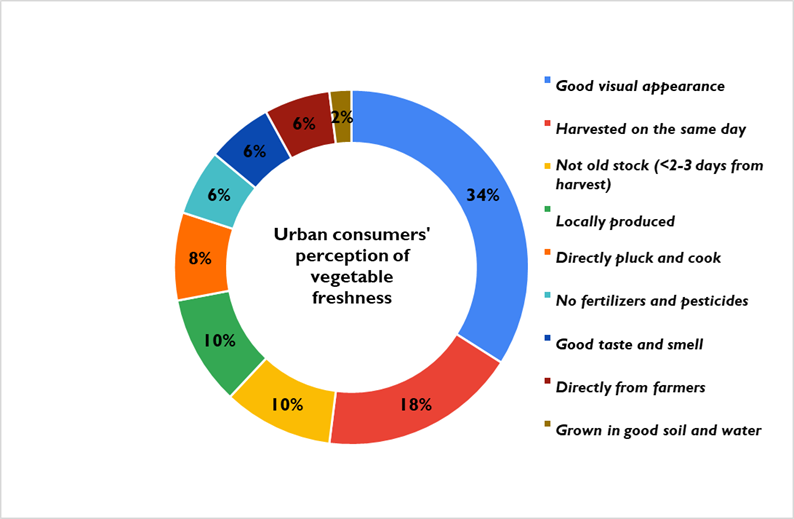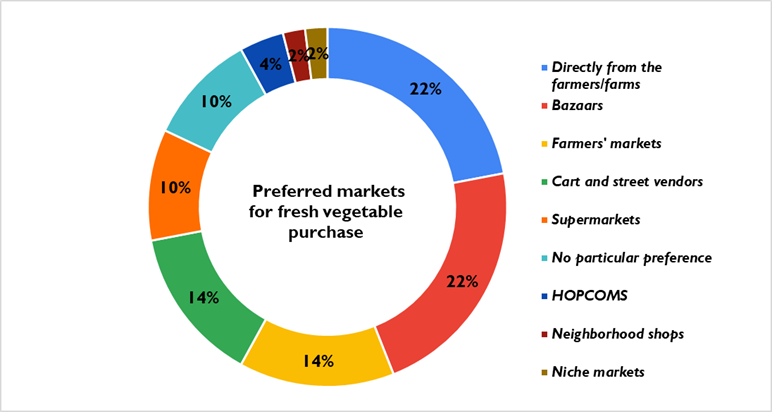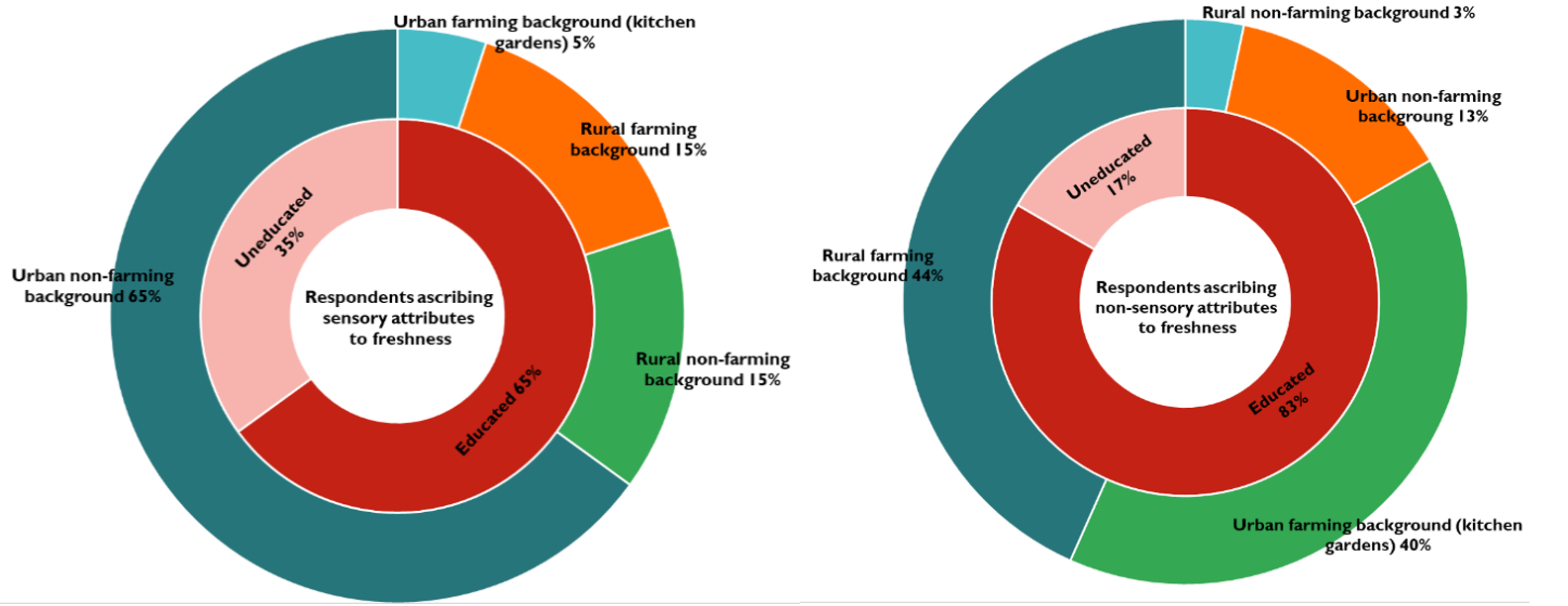With urban Indians increasingly seeking healthy lifestyles, the demand for fresh produce has escalated. In this note, Raj, Purushothaman and Sadashiva discuss findings from their survey in Bengaluru, exploring perceptions around the ‘freshness’ of produce among different consumer groups, and factors influencing consumer choices. They contend that a relationship of trust between producers and consumers can enable convergence of quality, nutrition and food safety in farm produce.
India is experiencing a boom in the demand for fresh vegetables and fruits – both in terms of quantity and variety – as many are making the switch to healthier lifestyles. A NITI Aayog report (2018) estimated that the demand for and household consumption of fresh produce would increase by 30% over the next four years. This trend has borne out in Bengaluru for instance, driven by expanding population and changing consumption patterns. HOPCOMS data reveal that in FY2020-21, Bengaluru consumed around 9,150 tonnes of fresh vegetables from various outlets across the city (Purushothaman et al. 2022).
‘Freshness’ of vegetables is a key consideration for consumers, who believe that it represents the quality of the produce. In consumer studies, the meaning of freshness boils down to the following: the appearance of the produce as being fresh from harvest, proximity to the farm, nutritional value, and the extent of post-harvest handling (Roque et al. 2018, Saba et al. 2018). The term freshness evokes both sensory and non-sensory attributes of the produce, with the perspective of freshness informed by the experience of taste, sight, smell and touch (organoleptic characteristics) constituting the sensory attributes (Zhang et al. 2016).
In a survey conducted in Bengaluru during April-May 2023, we explore the perceptions around the freshness of produce among different consumer groups, and the factors influencing consumer choices in the context of produce. The study involved a ‘purposive stratified sample’1 of 50 consumers in the city, who were surveyed via in-person and telephonic interviews.
Sensory and non-sensory attributes of freshness
Sixty percent of the respondents ascribe freshness to non-sensory attributes connected to the timing of harvest (minimal storage time, not old stock of beyond 2-3 days, harvested on the same day), mode of procurement (directly from the farmers), proximity to the place of cultivation (locally produced) and the method of production (grown in uncontaminated soil and water, no chemical fertilisers and pesticides).
As the distance between the place of cultivation and consumption increases, consumers tend to rely more on sensory attributes of freshness. Many of these urban consumers seem to consider eyes as gatekeepers to their taste buds. They visually evaluate the quality of produce. Among the 40% of consumers associating freshness with sensory attributes – 34% looked for attractive visual appearance like bright colour, absence of physical damage, shriveling or sogginess; the remaining 6% prioritised taste and smell. Many consumers often directly associate these characteristics with flavourful, juicy and crunchy vegetables.
Figure 1. What shapes perceptions of vegetable freshness among urban consumers
There are a few respondents (24%) who prefer vegetables that are locally sourced and recently harvested even when they are not very appealing visually (large sized, uniformly coloured produce displayed in supermarkets, procured from unknown sources). This preference can be attributed to a relationship of trust and familiarity with the producers – something that is hard to come by when consumers and producers are alienated from one another.
Where urban consumers shop for produce
Multiple factors have contributed to the alienation of consumers and producers, in the context of fresh produce. A few at the forefront are the emergence of retail markets and supermarkets, innovations in storage technologies, urban expansion, and rural-to-urban migration. Together with rising education levels and family incomes among urban consumers, these trends have promoted ‘organised fresh produce’ retailing in India. Modern markets have gained consumer patronage by offering diverse price ranges and new innovations (Natesan 2019).
Yet, the rise of sustainability discourses with regard to consumption, agriculture, soil health, animal welfare, and small family farms, has motivated a section of urban consumers to buy vegetables and fruits that are produced locally by small family farms with minimum synthetic inputs. Thus, even as organised retail of fresh produce grows, a majority of the high-income consumers (64%) in our sample rely on farmers’ markets, local markets and street vendors for their supply of fresh produce. This category of consumers believes that a part of the prices they pay reach small-farm families. The diversity in freshness perspectives becomes more noticeable as the niche market for locally grown, organic produce expands (Yousefian et al. 2021).
Figure 2. Preferred markets for purchase of fresh produce
Socio-cultural characteristics of consumers driving perspectives of freshness
Freshness perceptions seem to vary with age, cultural background, education, lifestyle and occupation of the consumer. Higher levels of formal education, age, and rural background prompt consumers to value non-sensory attributes of freshness. More than 60% of respondents with higher secondary education and above use non-sensory attributes to define freshness, while 80% of respondents with lesser formal education rely on sensory cues to assess the freshness of produce. About 50% of respondents with an urban/sub-urban upbringing and lifestyle associate freshness with sensory attributes, particularly with visual appearance.2 Our earlier surveys showed that such consumers who relate freshness (and consequently nutritional quality) to appearance prefer to buy vegetables from premium stores (Purushothaman et al. 2022).
Respondents who are aware of the location of cultivation, those with rural farming backgrounds, and who grow vegetables themselves in home gardens also describe freshness through non-sensory attributes (Figure 3). Such consumers would prefer to buy vegetables from markets where they can potentially verify these characteristics. This implies that the produce should be sourced from nearby areas, minimising post-harvest handling. Such procurement of produce could be from a known farmer, a farmers’ market or a kitchen garden in the neighbourhood. Around 66% of our respondents prefer buying produce directly from farmers, farmers’ markets or large bazaars (established, old local markets). Additionally, a small proportion of respondents believe that it is impossible to get fresh produce in the city since it is susceptible to quality deterioration during transportation. The desire to obtain fresh and nutritious produce emerges as the motivation behind an increase in urban farming and terrace gardens in the city (Nath et al. 2021).
Figure 3. Socio-cultural features of respondents and their freshness perceptions
Visual appeal and nutritional value of vegetables
Consumers associate physiological changes in texture (such as bruising, discoloration, shriveling, and so on) with deteriorating nutritional status of the produce and microbial activity. Vegetables have the highest nutritional content when they are harvested during peak maturity (Breene 1994). However, when the produce travels long distances to feed distant populations, it is often harvested before maturity to prevent post-harvest decay during transportation and handling. A lot of inputs go into storage and processing to deliver unspoiled forms of perishable produce to consumers. Post-harvest conditions (importantly temperature, light, and processing) negatively impact the visual appearance, nutritional status and palatability of fresh produce. The visual appeal needs to be maintained until the produce enters the consumer carts in distant supermarkets (Brasil and Siddiqui 2018). Thus, fresh produce is cooled and stored at optimum temperature after harvest. Cold storage arrests senescence, shriveling, discoloration, dehydration, metabolic changes and microbial activity (Nunes 2008).
Research suggests that freshly harvested produce without any processing (including dehydration, blanching and canning) will contain the optimal quantity of vitamins and minerals – any processing is considered to be nutrient destructive (Breene 1994). Consumers who prefer to buy local produce do so to avoid purchasing produce that undergoes a great degree of processing to maintain good visual appeal at the cost of nutrition. Bruising and other mechanical damage from rough handling, high temperature and exposure to light during transportation and storage can damage cell wall and membranes exposing nutrients to oxidative enzymes. In green leafy vegetables particularly, colour and appearance directly translate to nutrient content. These vegetables are prone to quick leaf senescence post-harvest, resulting in losses in chlorophyll, protein and antioxidants (Huang et al. 2019). Hence, good visual appearance and texture can indeed indicate the nutritional value of fresh produce in certain cases – but this is not always applicable.
Unlike processed and packaged food, fresh produce is not supposed to carry a label with nutritional status or the producer’s details. The caveat is that even if the produce is visually appealing and contain expected nutrients, it may be unsafe to consume. Agents used for enhancing visual appeal during production and post-harvest treatment, including cleaning agents, coating, paint, and pest control chemicals can cause poisoning (both acute and chronic) in consumers (Hussain 2017). As the demand for visually appealing vegetables increases in the global food market, so does the use of agents such as copper sulphate, rhodamine oxide, malachite green, petroleum oil, synthetic wax, etc. (Dey and Nagababu 2022). Hence, even if sensory attributes reflect nutritional status (though the latter depends on a whole lot of other factors, as discuss earlier), there may be hidden food safety risks.
Summing up
Food and nutritional requirements of an expanding urban population, along with a large rural population relying on primary production for their consumption and livelihoods, demand a careful analysis of the perceptions and reality around the quality of agricultural produces. Streamlining the array of ideas, facts and perceptions on freshness can inform the choices made by consumers and producers. Informed choices by consumers and producers can consequently enhance transparency in fresh produce markets that can meet the expectations of various sections of consumers and producers.
While sensory attributes of freshness can speak for the nutritive content to an extent, it cannot always guarantee it – nor can it ensure food safety. On the other hand, non-sensory attributes of freshness among consumer groups can nurture shorter supply chains built on transparency and trust between producer and consumer. This in turn can ensure convergence of quality of fresh farm produce, food safety and nutrition. This integration has to begin with understanding different popular perceptions of freshness, creating platforms for various categories of consumer and producer communities, and designing tailored marketing channels to ensure that consumers are well-informed.
This research is funded by the Department of Biotechnology (DBT), Government of India, under the Indo-German Collaborative Research Center. The content and opinions expressed are that of the authors and are not necessarily endorsed by/do not necessarily reflect the views of Azim Premji University.
Notes:
- Under purposive stratified sampling, we divided the population into subgroups (based on age, gender, occupation, income class and upbringing), decided a sample size for each subgroup, and then randomly chose a sample from each subgroup. This ensures that the sample is representative of the entire population to make meaningful conclusions.
- 40% of the total sample (20 respondents) come from a rural background. Among them, 50% are educated while the remaining are mainly migrant/daily wage labourers. Among the respondents with urban upbringing (30 in number), a major proportion is educated (93%).
Further Reading
- Brasil, IM and MW Siddiqui (2018), 'Postharvest Quality of Fruits and Vegetables: An Overview', in Siddiqui, MW (ed.), Preharvest Modulation of Postharvest Fruit and Vegetable Quality, Academic Press.
- Breene, William M (1994), "Healthfulness and Nutritional Quality of Fresh Versus Processed Fruits and Vegetables: A Review", Foodservice Research International, 8(1): 1-45.
- Dey, Subhashish and Bommu Hema Nagababu (2022), "Applications of food color and bio-preservatives in the food and its effect on the human health", Food Chemistry Advances, 1.
- Huang, Xingyi, et al. (2019), “Rapid and nondestructive detection of freshness quality of postharvest spinaches based on machine vision and electronic nose”, Journal of Food Safety, 39(6).
- Natesan, Ramesh Kumar (2019), “A Study on Consumer’s Perception on Fruits and Vegetables with Special Reference to Retail Outtarget="_blank" rel="noopener noreferrer"lets in Coimbatore City”, IOSR Journal of Business and Management, 21(3): 23-26.
- Nath, S, S Singh and S Swaraj (2021), ‘Terrace farming & gardening in Bangalore: Tracing the key motivations for adoption by residents’, Research Brief, Centre for Social and Environmental Innovation (CSEI). Available here.
- NITI Aayog (2018), ‘Demand & Supply Projections Towards 2033: Crops, Livestock, Fisheries and Agricultural Inputs’, Working Group Report, National Institution for Transforming India (NITI) Aayog, Government of India.
- Nunes, MCDN (2008), Color Atlas of Postharvest Quality of Fruits and Vegetables, Blackwell Publishing Ltd.
- Purushothaman, Seema, Vidya Puttur Sadashiva and K. M. Dhanush (2022), “Agroecological Impacts of Urban Demand for Fresh Vegetables: Preliminary Insights from Exploratory Surveys in Bengaluru”, Ecology, Economy and Society – the INSEE Journal, 5(2).
- Roque, Jeremy, Malika Auvray and Jeremie Lafraire (2018), “Understanding Freshness Perception from the Cognitive Mechanisms of Flavor: The Case of Beverages”, Frontiers in Psychology, 8.
- Saba, Anna, et al. (2018), “Towards a multi-dimensional concept of vegetable freshness from the consumer’s perspective”, Food Quality and Preference, 66: 1-12.
- Yousefian, Neda, M. Soubadra Devy, K. Geetha and Christoph Dittrich (2021), “Lockdown farmers markets in Bengaluru: Direct marketing activities and potential for rural-urban linkages in the food system”, Journal of Agriculture, Food Systems, and Community Development, 10(2): 105-121.
- Zhang, Ting, Karen Lusk, Miranda Mirosa and Indrawati Oey (2016), “Understanding young immigrant Chinese consumers’ freshness perceptions of orange juices: A study based on concept evaluation”, Food Quality and Preference, 48: 156-165.




 27 February, 2024
27 February, 2024 







Comments will be held for moderation. Your contact information will not be made public.